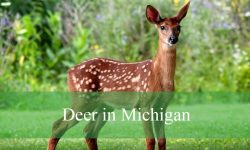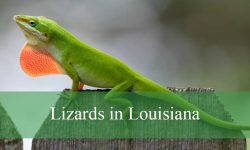Georgia is home to a vibrant variety of bird species, and among the most striking are the yellow birds in Georgia. These bright and beautiful birds bring bursts of sunshine to forests, fields, and backyards across the state. Birdwatchers and nature lovers alike find great joy in spotting these colorful birds during their outdoor adventures.
The diversity of yellow birds in Georgia includes small warblers, orioles, and meadowlarks, each with distinctive markings, behaviors, and preferred habitats. Some species stay in the state all year, while others pass through during migration or favor certain regions. This variety makes Georgia a rich destination for observing these cheerful birds.
This guide presents 20 of the most common and fascinating yellow birds in Georgia. With pictures and identification tips, it will help you recognize these sunny-feathered birds wherever you explore—from wooded swamps and open meadows to your own backyard.
Common Yellow Birds Found in Georgia
American Goldfinch
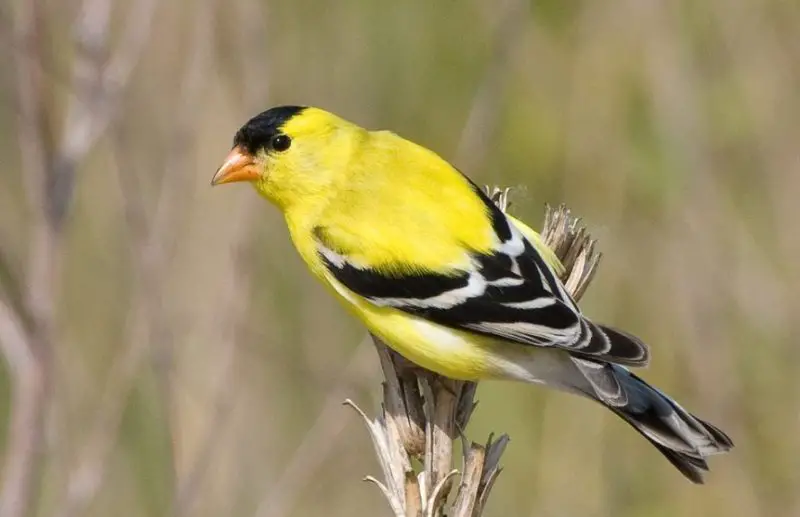
The American Goldfinch (Spinus tristis) is a small songbird known for its vibrant yellow plumage during the breeding season. Males are especially striking with bright lemon-yellow bodies, black wings with white bars, and a black cap. Females are duller in comparison, with olive-yellow coloring and no cap. In winter, both sexes molt into a muted olive-brown plumage, making them less conspicuous but still easily identified by their wing markings and flight call.
These finches are about 4.3 to 5.1 inches in length and weigh less than an ounce, making them one of the smallest feeder visitors in Georgia. They have a short, conical beak ideal for cracking seeds, especially from sunflowers and thistles. Their undulating flight pattern and delicate, sweet “per-chik-o-ree” call help in spotting them, even when their coloring blends in during colder months.
In Georgia, American Goldfinches are present year-round, though they are particularly common during the winter. They frequent open areas such as gardens, fields, and lawns and are regular visitors at backyard feeders stocked with nyjer or sunflower seeds. Their presence increases notably in suburban and rural areas during colder months when natural seed sources are scarcer.
Prothonotary Warbler

The Prothonotary Warbler (Protonotaria citrea) is a striking, bright yellow songbird with blue-gray wings and a distinctive, large black eye. The male displays the most intense yellow, especially on the head and breast, giving it a golden, glowing appearance. Females and juveniles are slightly paler but still easily recognizable due to their coloration and habitat preferences.
This species is around 5.1 inches in length and has a relatively stocky build for a warbler. It prefers wooded swamps, cypress stands, and wetland habitats, especially those with standing water. In Georgia, the Prothonotary Warbler is more frequently observed in the southern part of the state, where it breeds during the warmer months. The birds are cavity nesters, often using old woodpecker holes or nest boxes.
Their diet consists mainly of insects and other invertebrates, which they skillfully glean from foliage and low branches near water. Males sing a loud, ringing “sweet-sweet-sweet-sweet” song during breeding season to defend territory and attract mates. Due to their habitat specificity, birders typically encounter them in protected wetland reserves or remote wooded swamps in southern Georgia.
Common Yellowthroat

The Common Yellowthroat (Geothlypis trichas) is a small, secretive warbler with a bright yellow throat and breast. Males are easy to identify thanks to their bold black facial mask bordered by white or gray. Females lack the mask but share the overall olive upperparts and yellow underparts. This bird’s furtive behavior and rich song make it easier to hear than see.
Measuring about 4.3 to 5.1 inches in length, the Common Yellowthroat is commonly found in dense, brushy habitats such as marshes, grassy fields, and roadside thickets. In Georgia, they are widespread across the state, particularly during migration and breeding seasons. They are especially vocal during spring and early summer, often giving their characteristic “wichity-wichity-wichity” song from hidden perches.
Their diet primarily consists of insects, spiders, and other small invertebrates, which they forage for in low vegetation. While they may occasionally visit gardens with tall grasses or overgrown edges, they are more often encountered in wild, weedy areas. Their elusive nature means that a sharp ear is often the best way to locate them.
Yellow-rumped Warbler
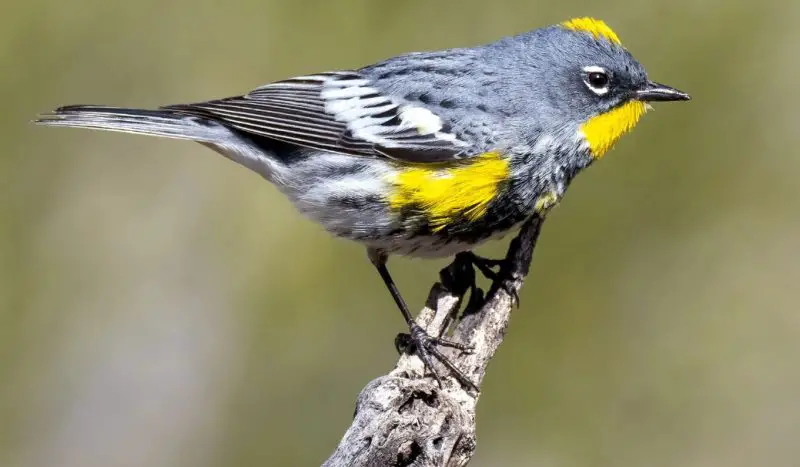
The Yellow-rumped Warbler (Setophaga coronata) is a versatile and highly recognizable species, especially during the non-breeding season. In its most common plumage, it sports grayish feathers with white wing bars, streaked sides, and distinct yellow patches on the rump, sides, and crown. The bright rump patch gives it the nickname “butterbutt” among birdwatchers.
This medium-sized warbler, measuring about 5.5 inches in length, is one of the few warblers that can digest the waxes found in bayberries and wax myrtles. This adaptation allows it to remain in Georgia throughout the winter, long after most other warblers have migrated. During winter, they are among the most abundant warblers in the state and are often found in mixed flocks with other songbirds.
In Georgia, Yellow-rumped Warblers are widespread during the cooler months, frequenting forest edges, parks, coastal areas, and backyards. They are active and vocal, often foraging in trees and shrubs, where they flit between branches while picking off insects or berries. Their cheerful “chek” calls and dynamic movements make them easy to spot in winter landscapes.
Pine Warbler
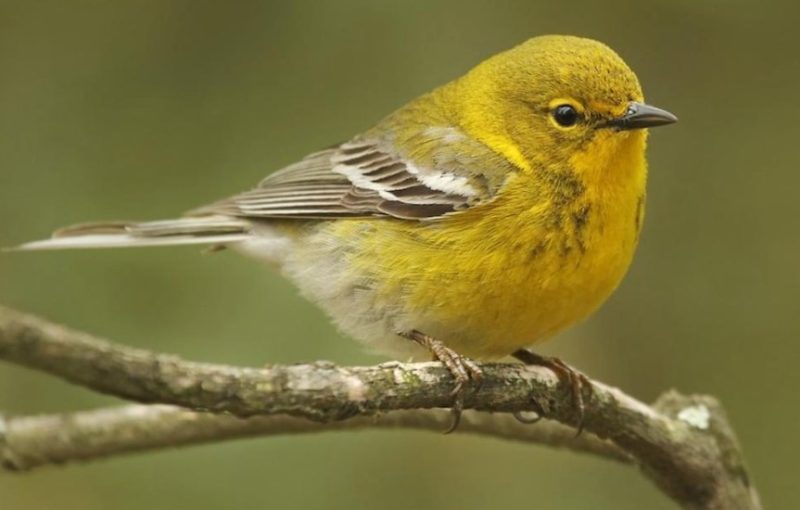
The Pine Warbler (Setophaga pinus) is a subtle but beautiful bird often overlooked due to its muted coloration compared to other warblers. Males are yellow on the throat and chest with olive-toned backs, while females and immatures tend to be duller, sometimes grayish with yellow tinges. White wing bars and a slightly stout bill help distinguish them from similar species.
Ranging from 5.1 to 5.5 inches in length, the Pine Warbler is a year-round resident in Georgia, especially in areas dominated by pine trees. As its name suggests, it prefers pine forests, where it often forages high in the canopy. However, during winter, these birds may venture lower and are known to visit feeders—particularly those offering suet, sunflower seeds, or mealworms.
Their diet includes insects, spiders, and seeds, with a notable increase in seed consumption during colder months. Males sing a musical trill that can resemble that of a Chipping Sparrow, but the Pine Warbler’s song is more musical and less mechanical. In Georgia, they are one of the few warbler species likely to be seen and heard even in the dead of winter, making them a favorite among local birders.
Prairie Warbler
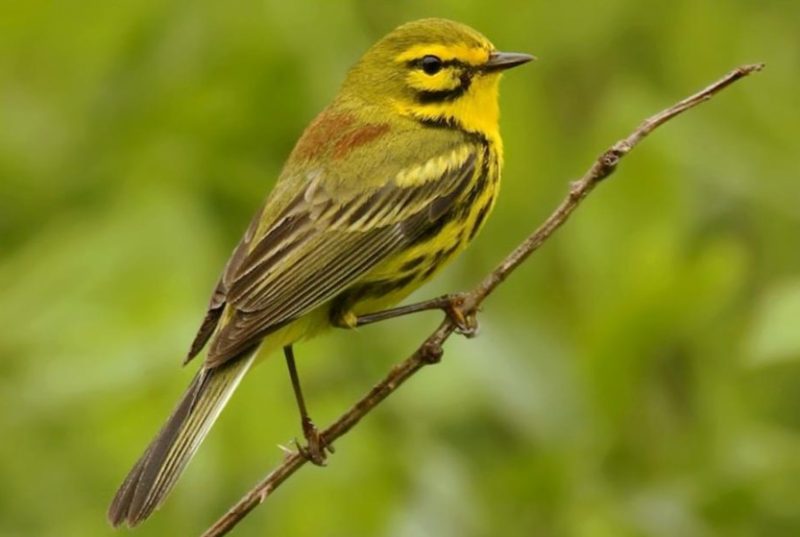
The Prairie Warbler (Setophaga discolor) is a small, vividly colored warbler with a yellow face and underparts marked by bold black streaks along the flanks. Males have a subtle chestnut patch on the back and dark facial markings, while females appear paler and more subdued in color. Despite its name, this bird prefers shrubby habitats rather than open prairies.
Measuring about 4.3 to 5 inches long, the Prairie Warbler is often seen flitting through brushy clearings, young pine stands, or regenerating fields. Its tail is frequently flicked as it forages for insects, which is a helpful behavioral clue for identification. The male’s song is a rising, buzzy “zee-zee-zee” that stands out during spring and early summer.
In Georgia, the Prairie Warbler breeds during the spring and summer months, especially in the southern and coastal regions. It favors areas with dense, low vegetation, such as old fields, power line cuts, and shrubby forest edges. While it migrates southward for the winter, it is a familiar and vocal presence throughout the warm season in the right habitats.
Hooded Warbler
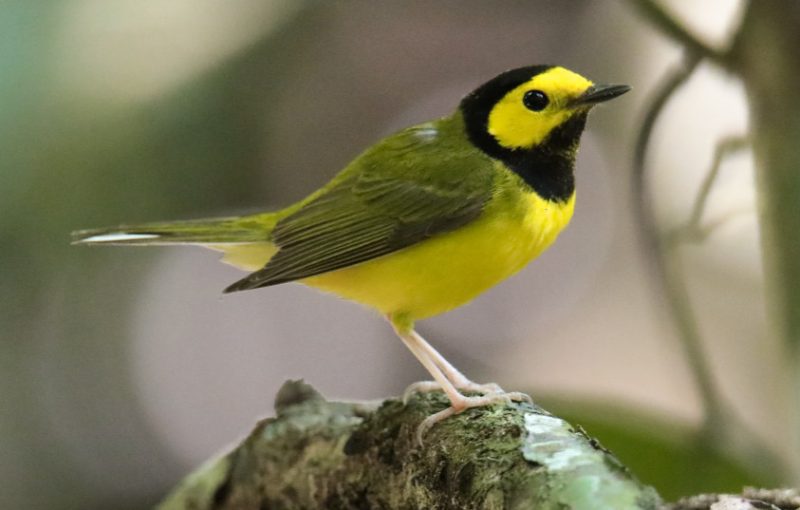
The Hooded Warbler (Setophaga citrina) is a striking summer visitor to Georgia’s shaded woodlands. Males are particularly distinctive with their bright yellow face and underparts contrasted by a bold black hood and throat. Females and immatures lack the full black hood but still show the bright yellow face that gives the species its name.
This warbler grows to about 5.1 inches in length and is most often found in deciduous forests with dense understory. It tends to stay low in the foliage, moving actively as it forages for insects and spiders. The male’s song is a clear, ringing series of notes—often described as “ta-wit ta-wit ta-wit tee-yo”—that echoes through mature woodlands in spring and early summer.
In Georgia, the Hooded Warbler is a breeding species during the warmer months, particularly in forested areas with deep shade and thick undergrowth. It is often heard before it is seen, as it tends to remain hidden in leafy cover. These warblers depart in late summer or early fall to migrate to Central America and the Caribbean.
Northern Parula

The Northern Parula (Setophaga americana) is a small and colorful warbler, easily recognized by its bluish-gray back, yellow throat and chest, and a green patch on its back. A white eye ring and partial chest band add to its distinctive appearance. Males are slightly brighter than females, but both are visually striking.
This species measures about 4.3 inches in length and prefers humid, mossy woodlands—especially near water. It is highly associated with Spanish moss and old man’s beard lichens, where it often builds its nest. The Northern Parula is quite vocal, and its buzzy, rising trill is a common sound in spring and early summer along Georgia’s rivers and streams.
In Georgia, Northern Parulas breed widely throughout the state, especially in moist forests near creeks and floodplains. They are among the earliest warblers to return in spring, and their high-pitched song often reveals their presence long before they are spotted flitting among the canopy. These birds migrate south in the fall to Central America and the Caribbean.
Yellow Warbler
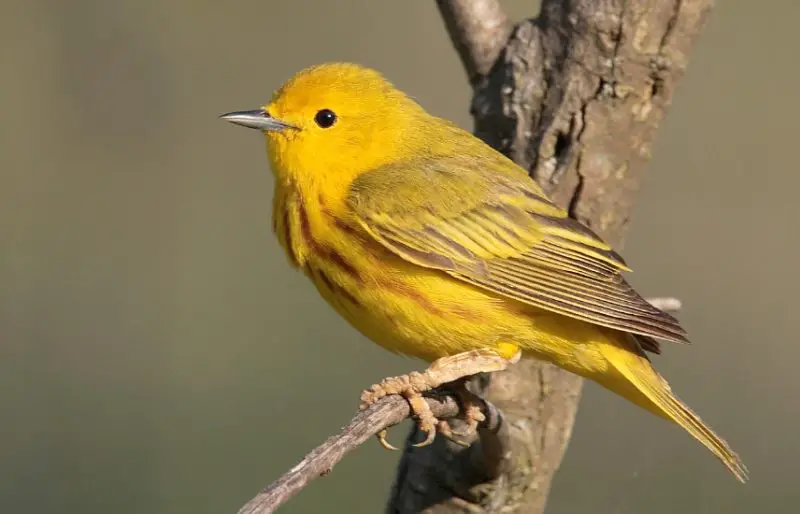
The Yellow Warbler (Setophaga petechia) is one of the brightest and most uniformly yellow warblers in North America. Males are lemon-yellow overall with subtle chestnut streaks on the breast, while females are slightly paler and lack the streaking. Their clear, bright coloring makes them easy to recognize, even from a distance.
They measure about 5 inches in length and are active, agile insectivores that forage in shrubs and small trees. The male’s cheerful song—often described as “sweet-sweet-sweet, I’m so sweet!”—is a hallmark of their presence during the breeding season. They prefer riparian habitats such as willow groves, thickets near streams, and wetland edges.
In Georgia, Yellow Warblers are spring and summer migrants, most commonly found in the northern and central parts of the state. Though not as widespread as some other warblers, they can be seen nesting near rivers and forest edges with dense low vegetation. By late summer, they begin their southward migration to Central and South America.
Orange-crowned Warbler
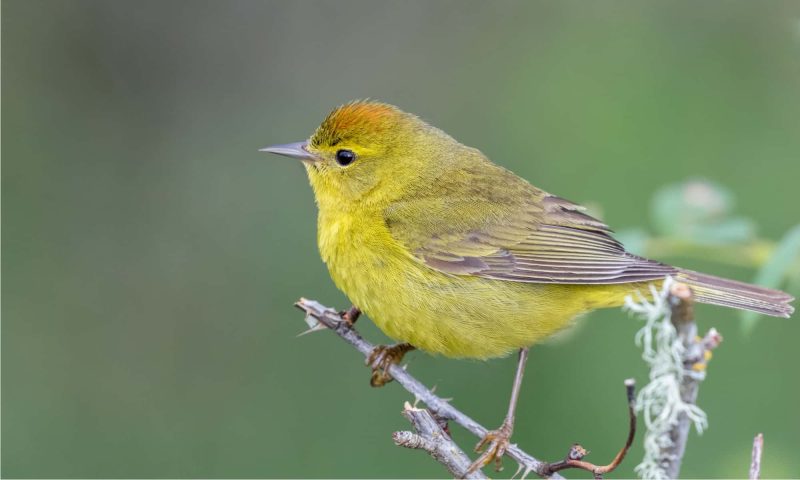
The Orange-crowned Warbler (Leiothlypis celata) is a subtly colored warbler, primarily olive-green above and yellowish below, with faint streaking. It lacks bold markings, though it has a thin, pale eye-line and, rarely seen, a tiny orange crown patch that gives the species its name. Because of its muted appearance, it’s often overlooked.
This small bird, about 4.3 to 5 inches in length, forages actively in low shrubs and understory, searching for insects, caterpillars, and berries. Its song is a soft, descending trill, much less conspicuous than the louder songs of other warblers. Orange-crowned Warblers are typically solitary and secretive, favoring dense foliage during feeding.
In Georgia, this species is not especially common but may be encountered during migration and in winter, especially in the southern part of the state. It prefers brushy habitats, weedy edges, and thickets, including overgrown fields and suburban plantings. Its quiet nature and drab coloring make it a challenge to spot, but it can be a rewarding find for patient observers.
Palm Warbler
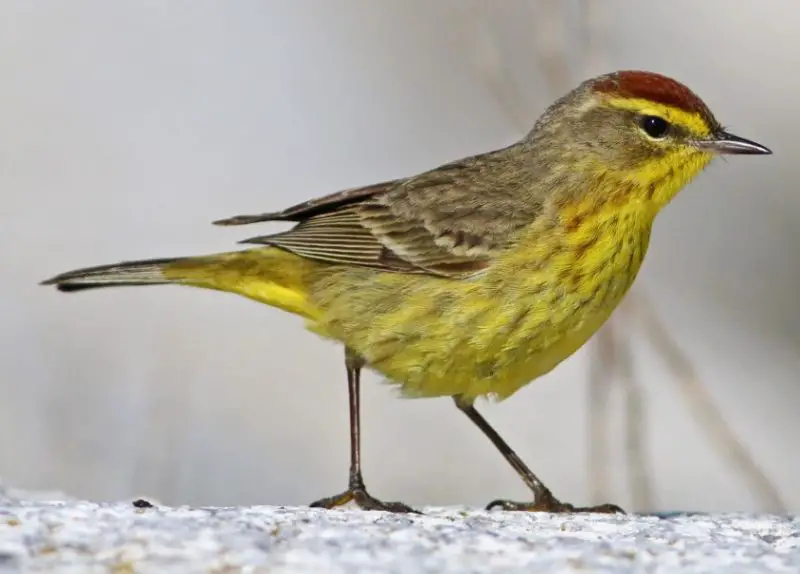
The Palm Warbler (Setophaga palmarum) is a small songbird recognized by its constant tail-wagging behavior and yellow undertail. It has a brownish back and cap with a yellow throat and undertail coverts. During fall and winter, the species appears more muted, while in spring, breeding adults show a rich rusty cap and brighter yellow below.
Measuring about 5 inches in length, the Palm Warbler prefers to forage on or near the ground. Unlike many warblers that stay high in trees, it is often seen hopping along open paths, grassy fields, or forest edges. It bobs its tail up and down nearly constantly, which is a distinctive behavior that helps with identification.
In Georgia, Palm Warblers are common migrants and winter visitors. They are typically seen from fall through early spring, especially in open areas like weedy fields, forest clearings, and park edges. While they breed far to the north in boreal forests, they are a familiar sight in Georgia’s milder seasons.
Yellow-throated Warbler
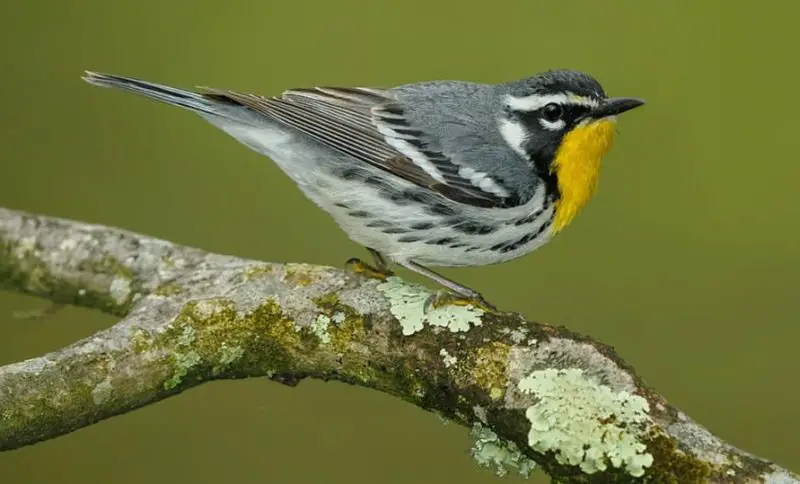
The Yellow-throated Warbler (Setophaga dominica) is a sleek and elegant songbird with a bright yellow throat, white belly, and striking black-and-white facial pattern. Its bluish-gray upperparts and long, slightly decurved bill complete its striking look. Males and females are similar in appearance.
At about 5.1 inches long, this warbler often stays high in the canopy, foraging among tall trees like pines, oaks, and sycamores. It moves gracefully among branches, searching for insects and spiders, and may occasionally hover to pick prey from leaves. Its sharp, clear song is a series of descending whistles that can echo through the treetops.
In Georgia, Yellow-throated Warblers are seen during spring and summer, especially in mature forests throughout the state. They prefer wooded habitats near rivers or swamps and are often spotted in coastal plain regions. Their fondness for tall trees and their high canopy activity make them a rewarding challenge for patient birdwatchers.
White-eyed Vireo

The White-eyed Vireo (Vireo griseus) is a compact, energetic bird known for its piercing white eyes and yellow spectacles around the face. It has olive-green upperparts and whitish underparts with yellow flanks, giving it a subtle but attractive appearance. Both males and females look alike.
It measures about 4.3 to 5 inches in length and is often heard before it is seen. The bird has a distinctive, sharp, and choppy song that includes mimicry and repetitive phrases. It prefers thick underbrush and shrubby areas where it forages for insects, spiders, and other small invertebrates with quick movements and flicks of its wings.
In Georgia, White-eyed Vireos are common during the warmer months, especially in summer. They inhabit dense thickets, forest edges, overgrown fields, and hedgerows across the state. Their bold song and active behavior make them easier to locate, even though they tend to stay hidden in the foliage.
Great Crested Flycatcher
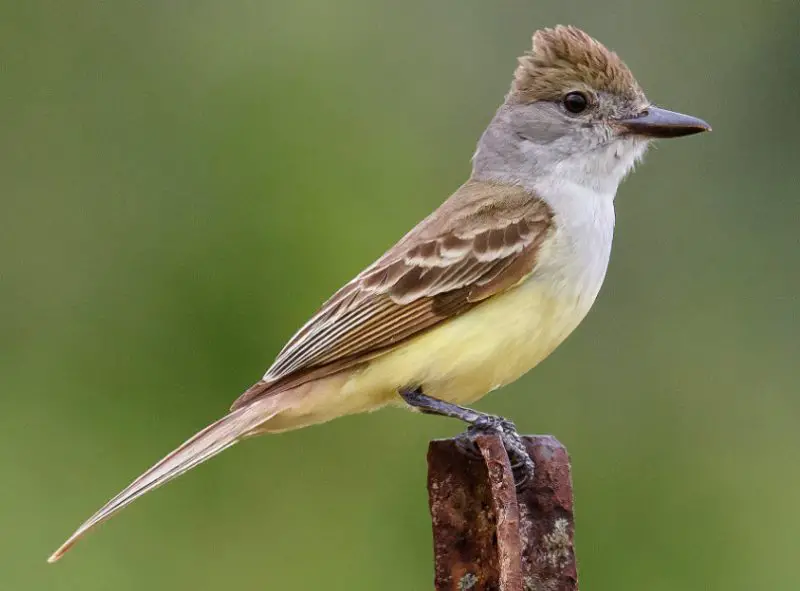
The Great Crested Flycatcher (Myiarchus crinitus) is a large and colorful member of the flycatcher family, with a lemon-yellow belly, rusty-colored tail and wings, and a gray throat and chest. It has a slightly crested head and a loud, ringing voice that echoes through forests.
At about 8 to 9 inches long, this flycatcher is one of the larger songbirds commonly found in Georgia’s woodlands during spring and summer. It perches high in the canopy and watches for flying insects, which it catches with agile mid-air sallies. It also eats small fruits and berries and is known to nest in tree cavities or bird boxes.
In Georgia, the Great Crested Flycatcher is a common breeding bird in deciduous forests and mixed woodlands. It arrives in spring and stays through late summer, often identified by its loud “whee-eep” call. Although it stays mostly high in trees, its striking colors and strong voice make it easy to recognize.
Eastern Meadowlark
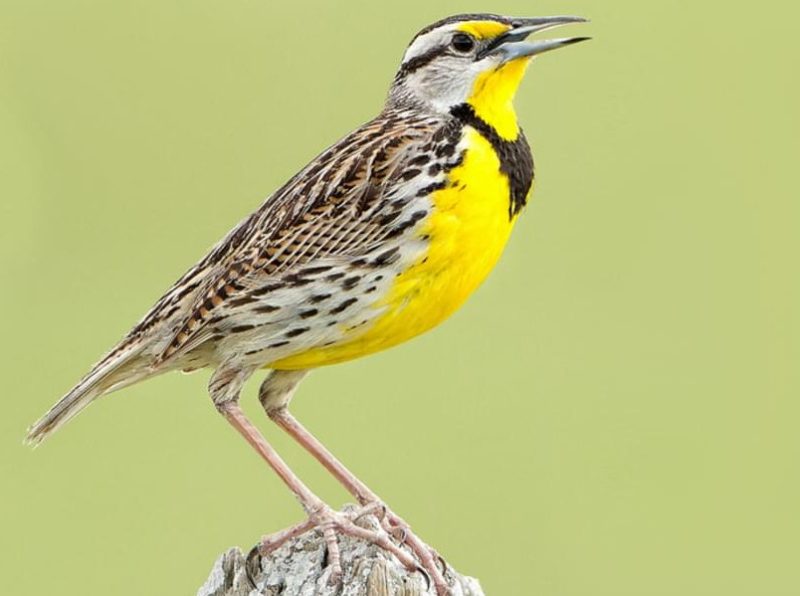
The Eastern Meadowlark (Sturnella magna) is a stocky, ground-dwelling songbird with a bright yellow chest marked by a bold black “V.” It has brown-streaked upperparts that provide excellent camouflage in grassy environments. Males and females look alike, though males are usually more vocal.
This species measures about 8.5 to 10 inches in length and has a sharp, pointed bill well-suited for foraging insects and seeds. Unlike many songbirds, it nests on the ground in dense grasslands and is often seen walking or running rather than flying. Its flutelike song is clear and melodious, usually delivered from fence posts or low shrubs.
In Georgia, Eastern Meadowlarks are year-round residents, especially in open farmland, pastures, prairies, and grassy meadows. They are more commonly heard than seen during the breeding season, with males singing to mark their territories. Their preference for wide, open spaces makes them a signature bird of rural Georgia landscapes.
Blue-winged Warbler

The Blue-winged Warbler (Vermivora cyanoptera) is a bright yellow warbler with subtle but distinctive markings. It has bluish-gray wings with two white wing bars and a thin black eye-line that contrasts with its otherwise clean yellow face and underparts. Both sexes look similar, though females may be slightly duller in color.
Measuring about 4.3 to 5 inches in length, this species prefers early successional habitats such as shrubby fields, young forests, and overgrown clearings. It forages actively among low branches and shrubs for insects, spiders, and caterpillars. Its buzzy song, often described as “bee-buzz,” is a useful clue during migration stops.
In Georgia, the Blue-winged Warbler is an uncommon migrant, mostly observed during spring and fall migration. It may be spotted in lowland woods, parks, and shrubby edges, particularly in the northern half of the state. Though not a breeder in Georgia, birders occasionally find it in managed natural areas or during bird banding surveys.
Wilson’s Warbler
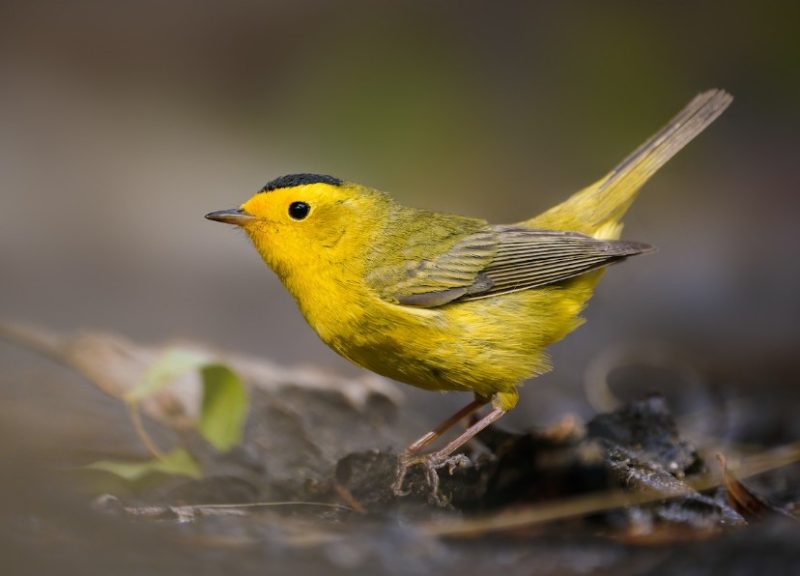
The Wilson’s Warbler (Cardellina pusilla) is a small, energetic warbler with a vivid yellow face and underparts. Males are easily recognized by their black cap, which stands out against their bright yellow head. Females and immatures lack the cap or may show only a faint shadow of it, but their overall golden-yellow coloration remains distinctive.
This warbler averages about 4.3 inches in length and prefers low, brushy habitats during migration. It forages close to the ground, quickly darting through dense vegetation in search of insects. Its call is a sharp “chit” and its song is a rapid, cheerful series of high-pitched notes.
In Georgia, Wilson’s Warblers are rarely seen but occasionally recorded during fall migration. They are more likely to be spotted in shaded gardens, forest understories, and damp thickets, particularly in the northern regions. Their fast-moving habits and small size can make them easy to miss unless carefully observed.
Baltimore Oriole (female)

The female Baltimore Oriole (Icterus galbula) has a warm, yellow-orange body with darker wings and white wing bars. Unlike the brilliant orange and black males, females are more subdued, with a lighter yellowish chest and olive-gray back, though they still possess a graceful and elegant appearance.
These birds grow to about 7 to 8 inches in length and are often seen foraging in the treetops for insects, nectar, and fruit. They use their slender, curved beaks to probe flowers and peel open soft fruit. Their presence is often revealed by their melodious, flutelike song and chatter-like calls.
In Georgia, female Baltimore Orioles are most likely to be observed during spring and fall migration. They visit forest edges, parks, and backyard gardens, where they may feed on oranges, jelly, or blooming flowers. Though they do not typically breed in Georgia, they are a treat for birders during their seasonal travels.
Orchard Oriole (female)
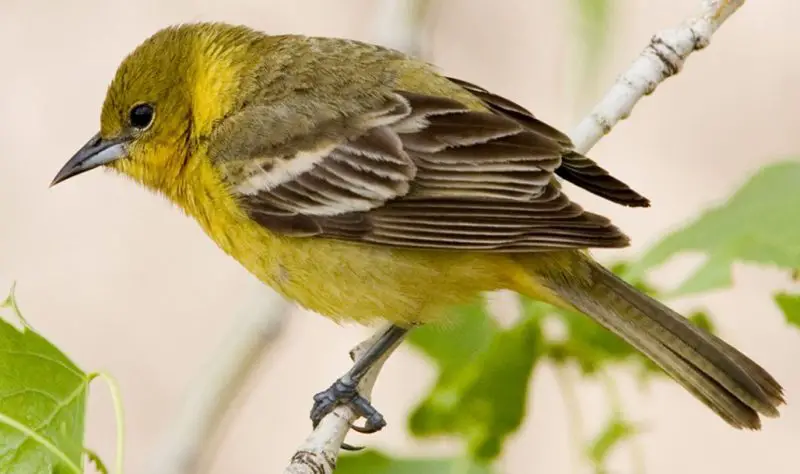
The female Orchard Oriole (Icterus spurius) is a soft yellowish-green bird with pale underparts and dusky wings. She lacks the bold chestnut and black coloration of the adult male, but her warm tones and slender silhouette make her elegant and easy to recognize with practice. Her overall shape is slim with a slightly curved bill.
This species measures around 6 to 7 inches long and prefers open habitats with scattered trees, such as orchards, forest edges, and grassy fields. Females forage among branches for caterpillars, beetles, and nectar, often joining mixed flocks. Their soft warbling call and chatters are usually heard from mid-canopy levels.
In Georgia, Orchard Orioles are summer residents, breeding in open woodlands and edges throughout much of the state. Females help build the nest—a hanging cup suspended from a forked branch—where they raise their young. They are more subtle than males but no less important to the breeding population during the warm months.
Dickcissel
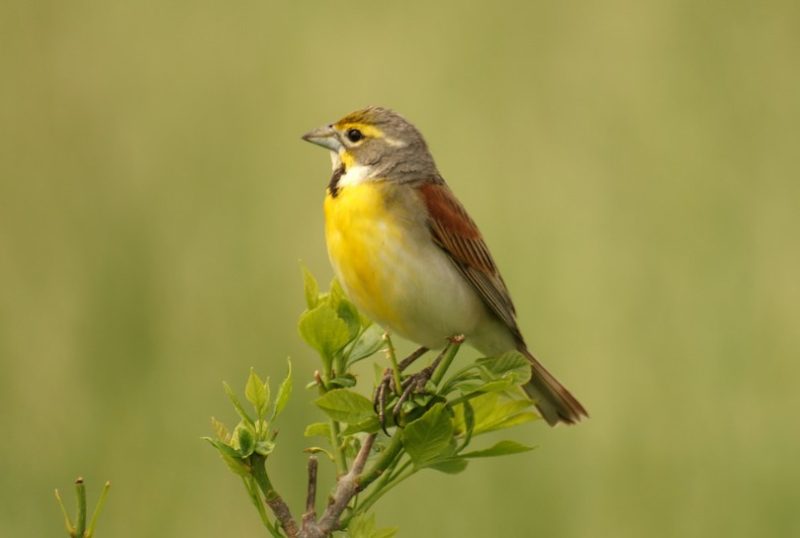
The Dickcissel (Spiza americana) is a chunky, sparrow-like songbird with a thick bill and a bright yellow breast marked by a distinctive black “V” shape. Males are more vividly colored, while females and young birds are browner and lack the bold chest marking, making them resemble large sparrows with yellow tinges.
Measuring about 6 inches in length, Dickcissels are known for their simple, buzzy songs—often rendered as “dick-dick-ciss-ciss-ciss”—which they sing repeatedly from perches in open fields. They forage on the ground and low vegetation for seeds and insects, especially during the breeding season.
In Georgia, Dickcissels are mostly seen during migration or in summer breeding populations that vary by year. They prefer grasslands, hayfields, and weedy pastures, mainly in the central and southwestern regions. Though not consistent breeders in Georgia, they occasionally appear in good numbers when habitat conditions are favorable.
FAQ about Yellow Birds in Georgia
What are the most common yellow birds in Georgia?
Some of the most common yellow birds in Georgia include the American Goldfinch, Pine Warbler, Yellow-rumped Warbler, and Common Yellowthroat. These species are frequently seen in backyards, forests, and open fields depending on the season. The American Goldfinch, for example, is especially abundant during the winter months.
Do yellow birds live in Georgia year-round?
Yes, some yellow birds are year-round residents in Georgia, such as the Pine Warbler and the Eastern Meadowlark. Others, like the American Goldfinch and Yellow-rumped Warbler, are more common during specific seasons like winter, while species such as the Yellow Warbler and Hooded Warbler are primarily seen in spring and summer.
Where can I see yellow birds in Georgia?
Yellow birds in Georgia can be spotted in a variety of habitats. Parks, backyards with bird feeders, pine forests, swamps, and grassy fields are all great places to observe them. For example, Prothonotary Warblers are best found in swampy woodlands, while Palm Warblers often forage on the ground in open areas during fall and winter.
What do yellow birds in Georgia eat?
Most yellow birds in Georgia eat insects, seeds, or berries depending on the species and season. Warblers typically feed on insects and spiders, especially during breeding season. Species like the American Goldfinch prefer seeds, while the Yellow-rumped Warbler is known to consume berries such as wax myrtle during winter.
How can I attract yellow birds to my backyard in Georgia?
To attract yellow birds to your yard, provide food sources like sunflower seeds, nyjer seed, and suet. Planting native trees, shrubs, and flowering plants can also help attract insectivorous species. Maintaining a birdbath or water source is beneficial, and adding nesting boxes may attract cavity-nesting species like Prothonotary Warblers.
Are yellow birds in Georgia migratory?
Many yellow birds in Georgia are migratory. For instance, the Yellow Warbler, Blue-winged Warbler, and Wilson’s Warbler are migrants that pass through the state during spring or fall. Some species, like the Pine Warbler and Eastern Meadowlark, stay throughout the year, while others are only seasonal visitors.
What is the difference between a female Baltimore Oriole and a female Orchard Oriole?
Female Baltimore Orioles are typically larger and more orange-yellow with a lighter belly and bold wing bars. In contrast, female Orchard Orioles are smaller and have a more olive-yellow coloration with dusky wings. Both may visit similar habitats during migration or the breeding season in Georgia.

